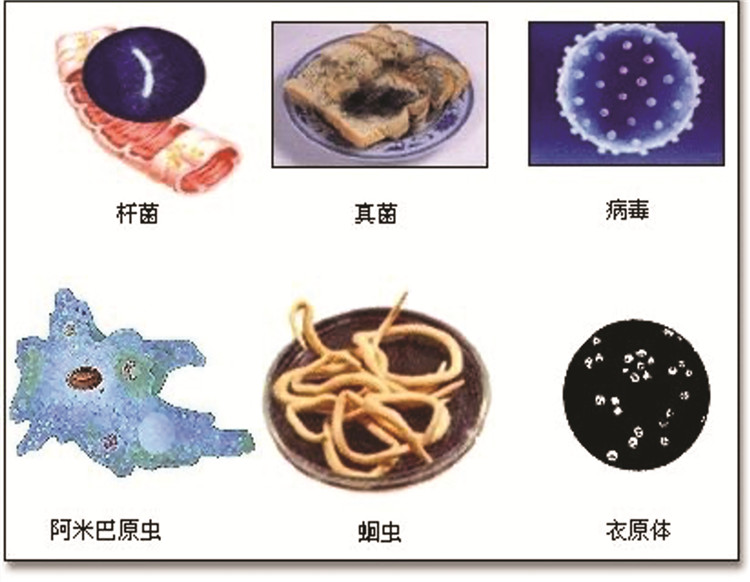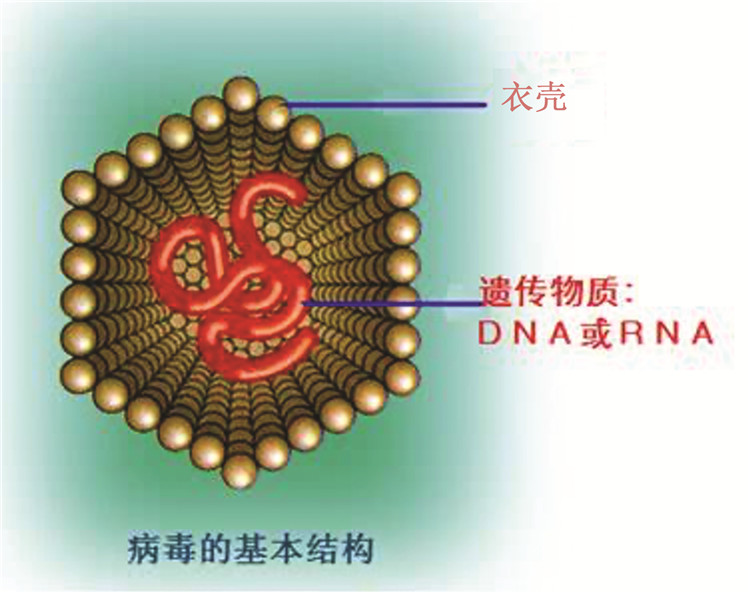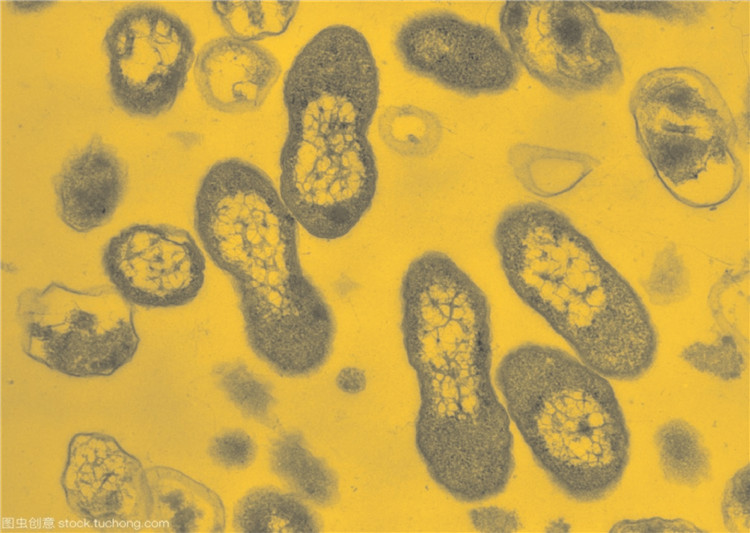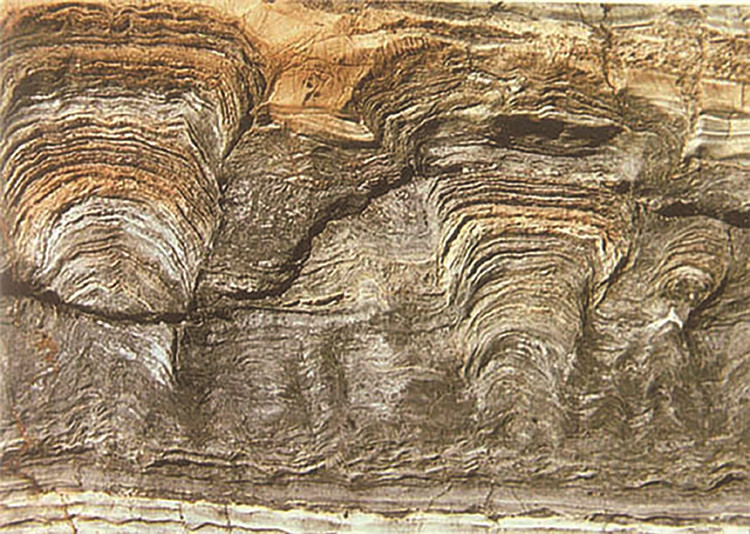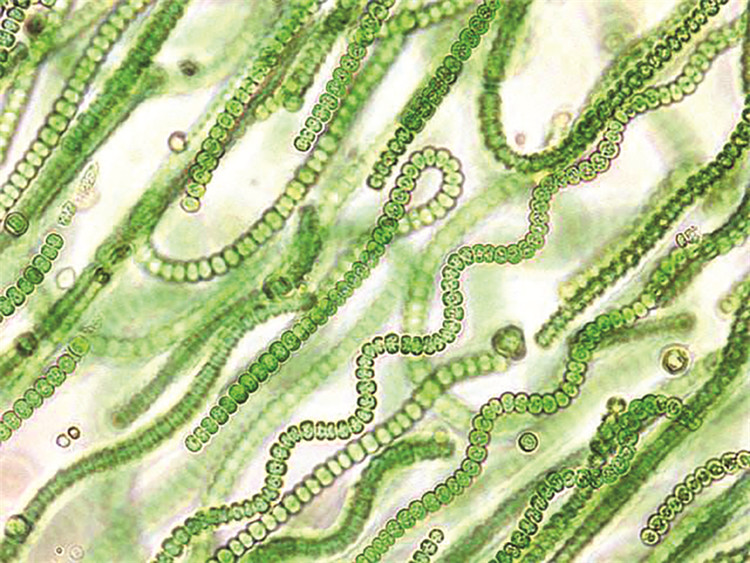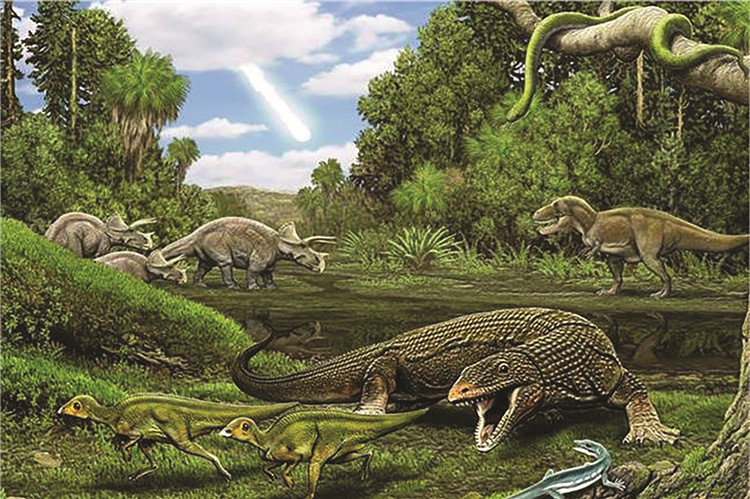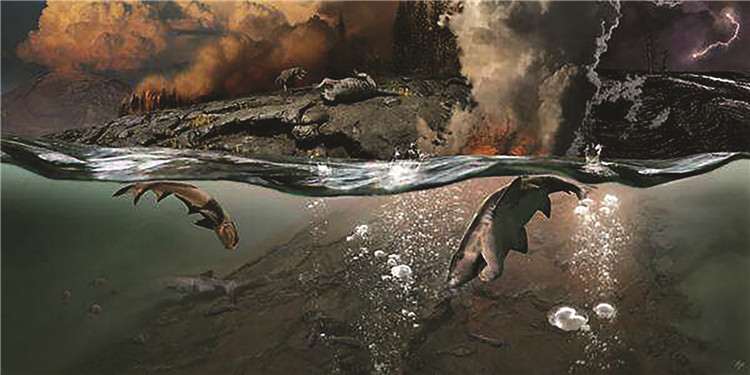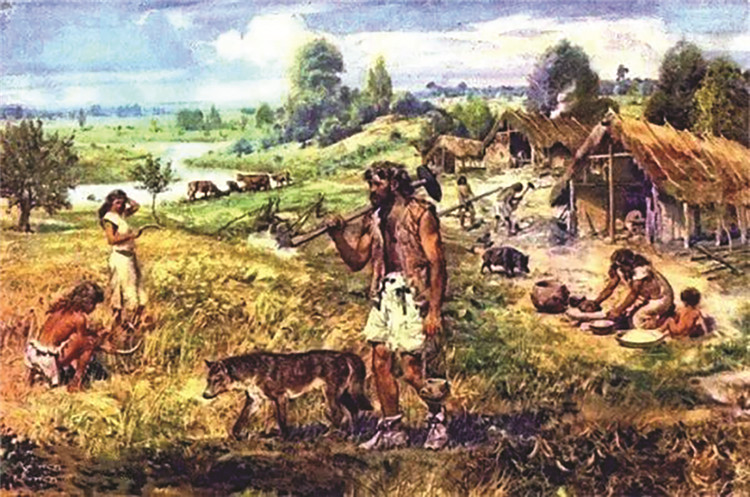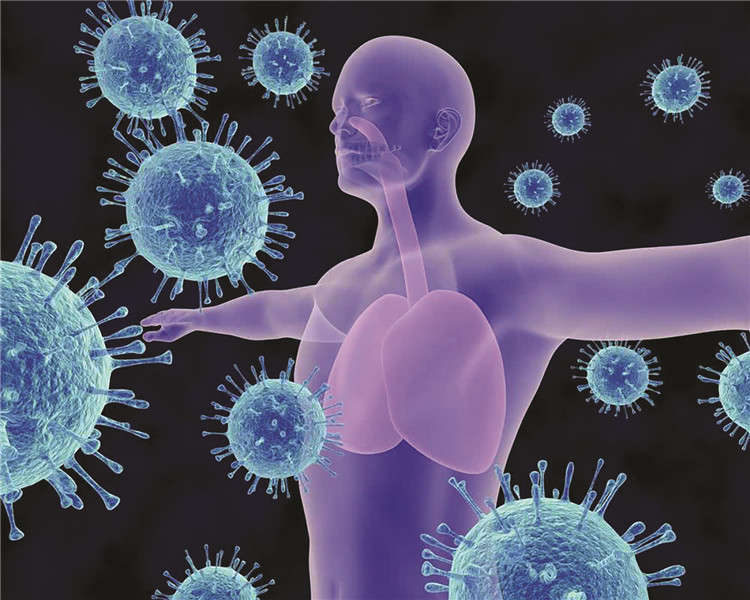The role of viruses and bacteria and other microorganisms in the history of the earth biological evolution
-
摘要:
病毒与细菌统称为微生物。病毒与细菌之害是生物生存遭遇到的最大的灾害,不仅在人类社会历史上留下了深重灾难,而且在地球生物演化史上也是大灭绝的重要推手。虽然病毒和细菌难以形成实体化石,但却以一种特殊的分子化石成为了侦探地质时期生物大灭绝的神针。本文以地球微生物学为指导,以蓝细菌和绿硫细菌分子化石为例,综合有关研究成果,解读了微生物学、病毒和细菌以及微生物岩的有关知识,帮助人们认识地球生物演化史上二次重要的大灭绝事件。本文还从人类演化过程中的农业革命,阐明了人菌共生关系及带来的启示。
Abstract:Viruses and bacteria are generally called microorganisms. The disaster of viruses and bacteria is the biggest one encountered by living creatures. It not only has left a serious disaster in the history of human society but also has been an important promoter of the mass extinction in the history of the evolution of the Earth's life. Although it is difficult for viruses and bacteria to form solid fossils, a special molecular fossil has become a magic needle for the detection of biological extinction in geological times. With earth microbiology as the guide and cyanobacteria and green sulfur bacteria molecular fossils as the study case, the authors comprehensively explained relevant research results and interpreted the relevant knowledge of microbiology, viruses and bacteria, and microbial rocks, thus helping people understand the two most important events of mass extinction in the history of the earth's biological evolution. This paper also clarifies the association relationship between human and fungus based on the enlightenment from the agricultural revolution in the process of human evolution.
-
Keywords:
- viruses /
- bacteria /
- microbiology /
- biological evolution /
- mass extinction /
- green sulfur bacteria /
- cyanobacteria
-
1. 研究目的(Objective)
尼玛盆地构造上位于班公湖—怒江缝合带中部,是发育在侏罗系—白垩系海相地层之上的古近系陆相裂谷盆地,北接羌塘地块,南邻冈底斯地块,近东西向展布,面积约3000 km2。本次研究目的是初步查明尼玛盆地东部冻土发育特征,调查盆地东部古近系地层层序,获取古近系烃源岩、储盖层等关键评价参数,进一步评价盆地油气资源潜力。
结合新获取的大地电磁测深、地表地质调查及藏尼地1井资料,通过对盆地东部石油地质条件的进一步论证,中国地质调查局油气资源调查中心在盆地东部赛布错坳陷部署实施了藏双地1井,该井的实施对于西藏高原陆相盆地的油气勘探具有重要意义。
2. 研究方法(Methods)
通过资料的收集和重新处理解释,建立了尼玛盆地基础资料数据库,结合之前在尼玛盆地东部发现的油气显示带及最新的大地电磁测深和藏尼地1井资料,优选井位。藏双地1井完钻井深1206.78 m,全井段进行了取心、录井和测井,共有岩心407箱,岩心总长1108.88 m,收获率95.9%。在古近系牛堡组选取烃源岩样品进行地球化学分析测试,通过分析有机质丰度、有机质类型、热演化成熟度来评价烃源岩生烃潜力;使用荧光分析仪对岩石进行荧光分析,主要进行干照和滴照实验,来检测岩石、岩屑中的沥青、烃类等有机物质。
3. 结果(Results)
藏双地1井从上到下钻遇地层依次为第四系+ 新近系—牛堡组三段—牛堡组二段(未穿),气测录井有3处气测异常段,总烃最高为0.159%,岩性为棕红色粉砂岩、灰色细砂岩。含气量解析取样井段527.90~1206.78 m,共取样54个,现场解析在标准大气压下最高含气量为0.213 m3/t;共做浸水试验20个,拍摄视频20个,其中井深744.40 m、752.08 m、767.30 m、774.66 m、797.20 m、832.43 m均有气泡冒出,以井深752.08 m最为明显。
荧光录井井段0~1206.78 m,对全井岩心按设计逐包进行荧光直照、拍照、氯仿浸泡,定级;全井共录取荧光资料421个点,其中井深1024.23~1026.23 m牛二段灰绿色泥岩断面处,可见黑色薄膜状干沥青,具荧光显示,干照下呈黄色、淡黄色,产状为星点状、带状,用氯仿滴照可呈片状;井深1077.46~1077.76 m牛二段见油迹;井深1078.16~1078.76 m牛二段见点状干沥青;井深1078.76~1079.16 m牛二段层理间见油斑;井深1079.16~1080.16 m牛二段顶部断面处见油迹,都具有荧光显示,呈黄色、淡黄色,产状为星点状、带状(图 1)。
4. 结论(Conclusions)
(1)藏双地1井全井取心,获得了尼玛盆地东部古近系地层层序、烃源岩及储层等相关参数,分别在牛三段418.43~422.00 m、牛二段890.00~898.00 m及1068.16~1087.00 m发现3处气测异常段,总烃最高为0.159%,现场解析含气量值最大为0.213 m3/t,并在牛二段1077~1080 m处发现不同级别的油气显示,首次实现了尼玛盆地地下油气的重要发现,对盆地下一步的勘探部署具有重要意义。
(2)本井是继藏尼地1井后在西藏尼玛盆地部署实施的第2口地质调查井,通过对藏双地1井的钻井技术攻关,进一步总结出了适合高寒缺氧、地表及地下地质条件复杂的高原钻井施工工艺和设备参数,为下一步在该区钻井施工提供了重要的技术支撑。
尼玛盆地平均海拔近4800 m,由于其高海拔的特殊性,具有高寒缺氧、气候恶劣、生态脆弱等特征,在野外施工过程中与其他地区有着很大的不同,通过藏尼地1井、藏双地1井的钻探,克服了高寒条件下冻土发育钻井技术难题和高原缺氧条件下深井取心难题,基本形成了一套安全、环保、高效的作业技术体系,为高原地区的钻探施工工程积累了丰富的经验。
5. 致谢(Acknowledgement)
感谢李韬、李显亮等同志的交流和启发。
-
图 4 叠层石(引自https://image.baidu.com/)
Figure 4. Stromatolite(after https://image.baidu.com/)
图 5 蓝细菌(引自https://image.baidu.com/)
Figure 5. Cyanobacteria (after https://image.baidu.com/)
图 6 二叠纪生物(引自https://image.baidu.com/)
Figure 6. Permian creatures (after https://image.baidu.com/)
图 7 二叠纪末生物大灭绝(引自https://image.baidu.com/)
Figure 7. Biological extinction in the late Permian (after https://image.baidu.com/)
图 8 农业革命开始的驯养家畜(引自https://image.baidu.com/search/)
Figure 8. Domesticated domestic animals at the beginning of the agricultural revolution(after https://image.baidu.com/search/)
图 9 人与新冠病毒(引自https://new.qq.com/rain/a/20200221A02ZBM00)
Figure 9. Human and novel coronavirus (COVID -19)(after https://new.qq.com/rain/a/20200221A02ZBM00)
-
Crice K, Cao Changqun, Love G D, Bottcher M E, Twitchett R J, Grosjean E, Summons R E, Tugeon S C, Dunning W, Jin Yugan. 2005. Photic zone euxinia during the Permian-Triassic superanoxic event[J]. Science, 307:709-714.
Dutkiewicz A, Volk H, George S C, Ridley J, Buick R. 2006.Biomarkers from Huronian oil-bearing fluid inclusions:An uncontaminated record of life before the Great Oxidation Event[J]. Geology, 34(6), 437. https://doi.org/10.1130/G22360.1.
Feng Weimin. 2020. Is domestication of animals and plants a source of infectious diseases?[J]. Global, 10:55-57 (in Chinese).
Joseph McCormick.1997. "Class IV Virus"[M]. Changchun: Jilin Publi shing House.
Holland H D. 2006. The oxygenation of the atmosphere and oceans.Philosophical Transactions of the Royal Society B: Biological Sciences, 361(1470), 903-915. https://royalsocietypublishing.org/doi/abs/10.1098/rstb.2006.1838.
Jin Dongyan. 2020. The past and present of human coronaviruses: where they come from and where they go. New Coronavirus Series 41. Sina Science and Technology "Science Master". https://tech.sina.cn/d/bk/2020-04-13/detail-iircuyvh7439332.d.html.
Kamo S L, Czamanske G K, Amelin Y, Fedorenko V A, Davis D W, Trofimov V R. 2003. Rapid eruption of Siberian flood-volcanic rocks and evidence for coincidence with the Permian-Triassic boundary and mass extinction at 251Ma[J].Earth and Planetary Science Letters, 214:75-91. http://www.wanfangdata.com.cn/details/detail.do?_type=perio&id=0a66e22d91aed1841f5aa74c8df7239a
Institute of Microbiology, Chinese Academy of Sciences. 2020. Microb iology classification. http://www.im.cas.cn/kxcb/wswdjt/201010/t20101028_2998683.html.
Li Shixue, Shan Ying. 2020. Latest research advances on novel coronavirus pneumonia[J]. Journal of Shandong university Health sciences, 58(3):19-25(in Chinese with English abstract). http://d.old.wanfangdata.com.cn/Periodical/shandykdxxb202003003
Liu Ning. 2020. The enemy of life——the past and present of the virus. Web of Science (in Chinese).
Li Deyao, Yang Xingwen, He Zhaokai, 2020. Popular science antiepidemic|Plague: Thousand-year black death haze. Kepu.gov.cn(in Chinese). http://www.kepu.gov.cn/www/article/4d2f3c94246b4273b605432ee6071df2
Qiu Zilong. 2020. Know yourself and know yourself: Regarding viruses, you must know these secrets. New Coronavirus Series 8.Sina Science and Technology "Science Master". https://tech.sina.com.cn/scientist/2020-02-07/doc-iimxxste9467544.shtml.
Rong Jiayu, Fang Zongjie. 2004. Biological Extinction and Recovery-Evidence from the Paleozoic and Triassic in South China[M]. Beijing: Science Press (in Chinese with English abstract).
Rong Jiayu, Xu Hankui, Feng Weimin, Fu Qiang. 2014. Ancient Disaster-Biological Extinction[M]. Nanjing: Jiangsu Science and Technology Press (in Chinese).
Shen S Z, Ramezani J, Chen J, Cao C Q, Erwin D H, Zhang H, Xiang L, Schoepfer S D, Henderson C M, Zheng, Q F, Bowring S A, Wang Y, Li X H, Wang X D, Yuan D X, Zhang Y C, Mu L, Wang J, Wu Y S. 2018. A sudden end-Permian mass extinction in South China: GSA Bulletin. https://doi.org/10.1130/B31909.1.
Shen Shuzhong, Wang Yue, Cao Changqun, Wang Xiangdong, Wang Wei, Zhang Hua. 2009. Permian biological extinction and Triassic biological recovery[C]//Century Leap: Brilliant Chinese Paleontology. Beijing: Science Press, 126-131 (in Chinese).
Shen Shuzhong, Wang Yue. 2018. Biological extinction at the end of the Permian. 214-227. Biological evolution and environment[C]//Biological Evolution and Environment. Hefei: China University of Science and Technology Press, 214-227 (in Chinese).
Suchard M A, Lemey P, Baele G, Ayres D L, Drummond A J, Rambaut A. 2018. Bayesian phylogenetic and phylodynamic data integration using BEAST 1.10[J]. Virus Evolution, 4(1):vey016.
Tang Cheng. 2020. Where does the virus come from? Science compound (in Chinese).
Xie Shucheng, Ruan Xiaoyan, Wang Yongbiao. 2009. Little Microbes tell the great disaster of the earth[C]//A Leap in the Century-A Brilliant Chinese Paleontology. Beijing: Science Press, 120-125.
Xie Shucheng, Yin Hongfu, Shi Xiaoying. 2011. Geobiology: The Interaction and Co-evolution of Life and the Earth's Environment[M]. Beijing: Science Press, 1-345(in Chinese with English Abstract).
Wang Liming, 2010. Where did the new coronavirus originate from? The global pandemic may be inevitable. The new coronavirus series 30. Sina Science and Technology "Science Master" (in Chinese). https://tech.sina.com.cn/scientist/2020-03-11/doc-iimxyqvz9496846.shtml.
Wang Liming. 2020. Where did the new coronavirus originate from? A global pandemic may be inevitable. New Coronavirus Series 30.Sina Science and Technology "Science Master"(in Chinese).
Wessner D R. 2010. The origins of viruses. Nature Education, 3(9), 37.
Ye Sheng, 2020. How are viruses different from cells? Human knowledge of viruses is very limited. New Coronavirus Series 31.
Sina Science and Technology "Science Master" (in Chinese). https://tech.sina.cn/scientist/2020-03-12/detail-iimxyqvz9773689.d.html.
Zhao Zhongquan, Sun Ming, Wan Xiaoming, Chen Shenghong, Zhao Jing, Song Lijun, Li Hui, Qiang Kunsheng, Liang Yongxing. 2020. The application of microbial exploration technology to the oil and gas survey of Chaoshan depression[J]. Geology in China, 47(3):(in Chinese with English abstract).
Zheng Hong. 2020. Epidemic prevention in Chinese history. Gmw.cn(in Chinese). http://www.gmw.cn/xueshu/2020-02/17/content_33565257.htm.
仇子龙, 2020.知己知彼: 关于病毒, 这些秘密你必须知道.新型冠状病毒之系列八.新浪科技《科学大家》. https://tech.sina.com.cn/scientist/2020-02-07/doc-iimxxste9467544.shtml 冯伟民.2020.驯养动植物是传染病根源吗?环球, 10:55-57. 黄波. 2020.聚焦新冠疫情: 人体防御病毒的免疫力究竟是什么?新型冠状病毒之系列二十.新浪科技《科学大家》. https://tech.sina.com.cn/roll/2020-02-25/doc-iimxyqvz5600205.shtml. 金冬雁. 2020.人类冠状病毒的前世今生: 从哪里来, 又要到哪里去. 新型冠状病毒之系列四十一.新浪科技《科学大家》. https://tech.sina.cn/d/bk/2020-04-13/detail-iircuyvh7439332.d.html 李德瑶, 杨兴雯, 贺兆锴. 2020.科普抗疫|鼠疫: 千年黑死病阴霾.中国科普网.http://www.kepu.gov.cn/www/article/4d2f3c94246b4273b605432ee6071df2 李士雪, 单莹. 2020.新型冠状病毒肺炎研究进展述评[J].山东大学学报(医学版), 38 (3):1-7. http://d.old.wanfangdata.com.cn/Periodical/shandykdxxb202003003 刘宁. 2020.生命的宿敌——病毒的前世今生.科学网(www.sciencenet.cn). 戎嘉余, 方宗杰.2004.生物大灭绝与复苏-来自华南古生代和三叠纪的证据[M].北京: 科学出版社. 戎嘉余, 许汉奎, 冯伟民, 傅强. 2014.远古的灾难-生物大灭绝[M].南京: 江苏省科技出版社. 沈树忠, 王玥, 曹长群, 王向东, 王伟, 张华. 2009.二叠纪生物大灭绝与三叠纪生物复苏[C]//世纪飞跃——辉煌的中国古生物学.北京: 科学出版社..126-131. 沈树忠, 王玥. 2018.二叠纪末生物大灭绝[C]//生物演化与环境.合肥: 中国科技大学出版社, 214-227. 唐骋. 2020.病毒从哪里来?科学大院. 王立铭. 2020.新冠病毒到底是从哪里起源?全球大流行可能难以避免.新型冠状病毒之系列三十.新浪科技《科学大家》. https://tech.sina.com.cn/scientist/2020-03-11/doc-iimxyqvz9496846.shtml. 约瑟夫·麦科明克.1997.第四级病毒[M].长春: 吉林出版社. 叶盛. 2020.病毒与细胞有何不同?人类对病毒的认知很有限.新型冠状病毒之系列三十一.新浪科技《科学大家》. https://tech.sina.cn/scientist/2020-03-12/detail-iimxyqvz9773689.d.html. 谢树成, 阮小燕, 王永标. 2009.小小微生物诉说地球大灾难[C]//世纪飞跃——辉煌的中国古生物学, 北京: 科学出版社, 120-125 谢树成, 殷鸿福, 史晓颖. 2011.地球生物学: 生命与地球环境的相互作用和协同演化[M].北京科学出版社.1-345. 郑洪. 2020.中国历史上的防疫斗争.光明网.http://www.gmw.cn/xueshu/2020-02/17/content_33565257.htm. 赵忠泉, 孙鸣, 万晓明, 陈胜红, 赵静, 宋立军, 李辉, 强昆生, 梁永兴. 2020.微生物勘探技术在潮汕坳陷油气勘探中的应用初探[J].中国地质, 47(3):. http://geochina.cgs.gov.cn/geochina/ch/reader/view_abstract.aspx?file_no=20200306&flag=1 中科院微生物研究所. 2020.微生物分类. http://www.im.cas.cn/kxcb/wswdjt/201010/t20101028_2998683.html. -
期刊类型引用(8)
1. 张云,张天福,程先钰,孙立新,程银行,王少轶,王善博,马海林,鲁超. 鄂尔多斯盆地东北部侏罗纪含铀岩系三维地质结构与铀成矿规律浅析. 中国地质. 2022(01): 66-80 .  本站查看
本站查看
2. 庞康,吴柏林,孙涛,郝关清,雷安贵,杨松林,刘池阳,傅斌,权军明,王苗,郝欣,刘明义,李琪,张效瑞. 鄂尔多斯盆地砂岩型铀矿碳酸盐岩碳氧同位素及其天然气-水混合流体作用特征. 中国地质. 2022(05): 1571-1590 .  本站查看
本站查看
3. 林兆民,张嘉冕. 甘肃省207铀矿及富铀岩体特征研究. 甘肃地质. 2022(04): 42-48 .  百度学术
百度学术
4. Reng-an Yu,Shan-bo Wang,Qiang Zhu,Qing-hong Si,Xue-ming Teng,Xiao-xue Liu,Hou-ning Liu,Yong-xiang Tang. Zircon U-Pb ages and provenance characteristics of the Zhiluo Formation sandstones and the formation background of the uranium deposit in Huangling area, Ordos Basin, China. China Geology. 2021(04): 600-615 .  必应学术
必应学术
5. 张天福,张云,金若时,俞礽安,孙立新,程银行,奥琮,马海林. 鄂尔多斯盆地东北缘侏罗系层序界面特征对砂岩型铀矿成矿环境的制约. 中国地质. 2020(02): 278-299 .  本站查看
本站查看
6. 张云,张天福,孙立新,程银行,张祺,王少轶,程先钰,周小希. 鄂尔多斯盆地南缘黄陵地区煤铀兼探钻孔数据集成与三维地质模型构建. 中国地质. 2020(S1): 231-254 .  本站查看
本站查看
7. 张天福,张云,程先钰,孙立新,程银行,周小希,王少轶,马海林,鲁超. 鄂尔多斯盆地北部东胜地区侏罗系-白垩系钻孔数据库与三维地质模型. 中国地质. 2020(S1): 220-245 .  本站查看
本站查看
8. 田亮,赵天林,尹永朋,李名,叶阳. 内蒙古二连盆地额仁淖尔地区铀成矿水文地质条件分析. 矿产勘查. 2020(11): 2424-2429 .  百度学术
百度学术
其他类型引用(0)




 下载:
下载:
